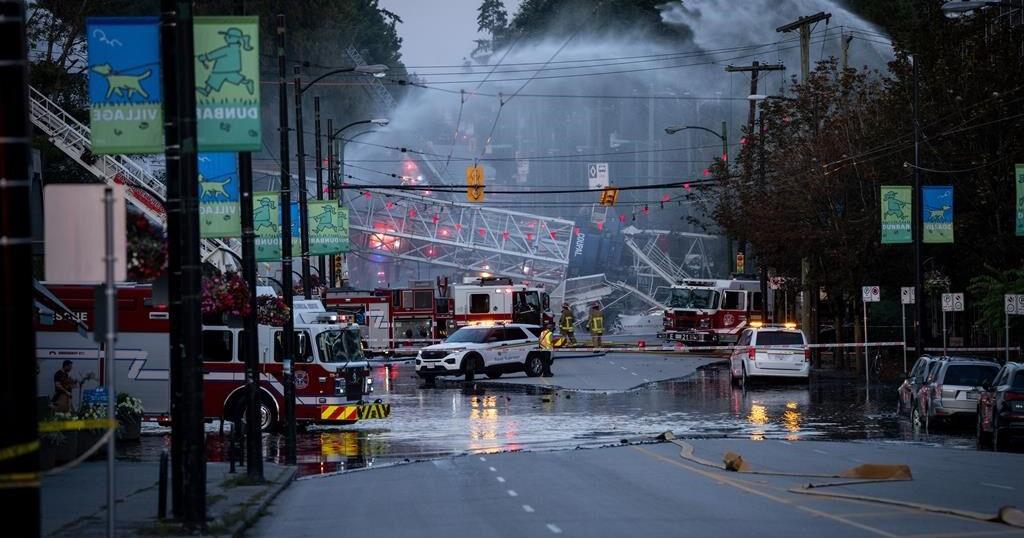VANCOUVER – Leslie Guerin watched ashes and burning embers the size of bowling balls falling from the sky in Vancouver on Tuesday night.
Guerin said he was 14 blocks away from a fire in the city when he heard four large explosions.
A fire was consuming a multi-storey apartment building under construction, while the flaming embers started nine other nearby homes on fire, and the crane being used to construct the apartment building collapsed onto a home across the street, the city’s fire department said.
Guerin said he was fixing his bicycle when he heard the blasts.
“My decision was, it’s an emergency, so I loaded my tools away and raced uphill with my bicycle,” said Guerin, who has been volunteering as part of a block watch program for the police department since 2008.
He said he arrived to witness the construction crane falling across the street. The heat from the fire was so hot, it felt like his jacket was melting, Guerin said in an interview on Wednesday.
“There were ashes falling down for about an eight-block radius in every direction and they were about the size of bowling balls, some of them were a foot by a foot in regards to insulation,” he said.
“There was a lot of material falling from the sky, from the winds, blowing the fire and smoke in one direction northwest where a lot of it went in that direction and a lot of homes where roofs did catch fire.”
More than 40 fire trucks flooded the area and police officers were in every direction he looked, he said.
The Dunbar neighbourhood was dark after power was cut off because of the fire, he said.
The fire broke out at about 6:30 p.m. Tuesday and Vancouver Fire Rescue Service said burning embers set off the additional fires, forcing people out of their homes and creating “excessive smoke” in the area of southwest Vancouver.
Keith Stewart, the department’s assistant chief, said in an interview that two of the nine homes were heavily damaged, while the rest suffered minor damage.
A statement from the department said roads in the area remain closed to traffic on Wednesday, as the crane will take time to clear.
Video posted on social media while the fire was raging shows the crane toppling as a column of thick, black smoke billowed into the sky.
Vancouver fire Chief Karen Fry said during a media availability that the crane landed in the middle of a home across the street from the burning building.
“An individual was trapped inside that house. Between our firefighters and (Vancouver police), we extricated that patient from a window in order to evacuate them from the house when it was safe to do so.”
It was the second major fire in Vancouver on Tuesday after flames broke out at a vacant apartment building that was slated for demolition. The fire service said the blaze along East 10th Avenue began at about 4:30 p.m. on Tuesday, and the city’s chief building official has ordered the building to be torn down with work starting in the coming days.
Mayor Ken Sim said during an unrelated news conference that the two fires around the same time stretched the department’s resources “incredibly thin.”
He said his heart goes out to all those who are affected by the fire.
Stewart said the cause of the fire at the Dunbar site and the circumstances that led to the crane collapsing are under investigation.
A couple of firefighters suffered minor injuries battling the blazes, he said.
A statement from the fire service said residents around the fire aren’t yet allowed to return to their homes.
Damini Singh, a first-year student at Langara College, said she was in bed Tuesday evening after writing an early-morning exam when explosions woke her.
“I thought, ‘what was happening,’ I could feel my whole bed was shaking because of the explosions,” said Singh.
“I heard that people were just screaming outside my house: get out of the house, get out of the house,” she said.
She stepped out of her home to see a mass of flames, then rushed back to grab some of her belongings.
After wandering around with her suitcase for a few hours, friends in neighbouring Burnaby gave her a place to stay for the night.
“I was hoping that once I came back in the morning, I could either go inside or just stay there. But now that I’m here, they just told us that the whole block is closed for safety reasons and I still don’t know when I will get an update and when will I come back here,” said Singh.
Tanya Faire said she was walking from her house to her car when she heard a big explosion, which “sounded like bombs dropping.”
Faire said the explosion was followed by another blast, and then she saw a plume of smoke and flames erupt from the fire.
“I think I felt startled. I was in Fort McMurray when the wildfires happened and had to get evacuated,” she said.
“My first thought was that looks like it could jump from house to house, and are we going to have to get evacuated?”
The City of Vancouver has directed displaced residents to Crofton House School at 3200 West 41st Ave., saying city staff were on site to provide assistance.
People outside that block of houses have been allowed to return home, though the fire service said BC Hydro was still working to restore power to some customers.
This report by The Canadian Press was first published Aug. 7, 2024.

























